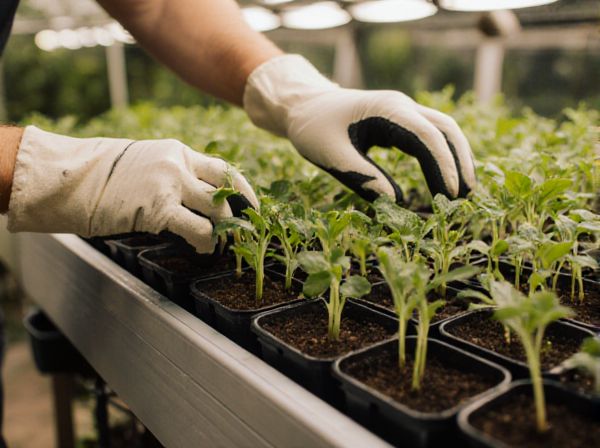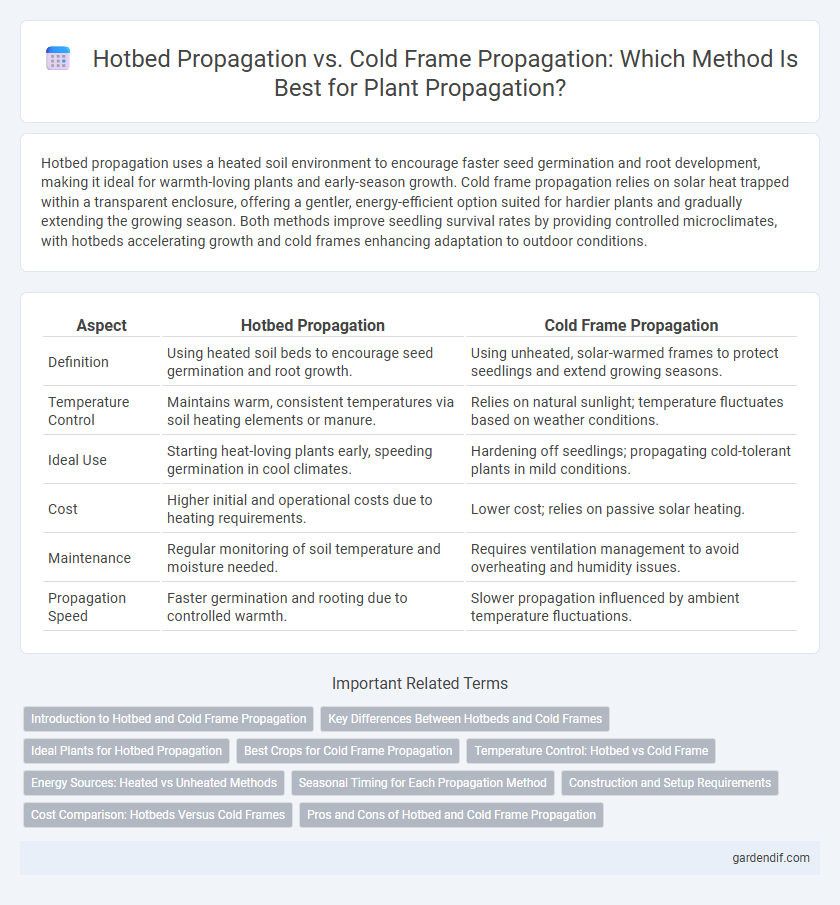
Hotbed Propagation vs Cold Frame Propagation Illustration
Hotbed propagation uses a heated soil environment to encourage faster seed germination and root development, making it ideal for warmth-loving plants and early-season growth. Cold frame propagation relies on solar heat trapped within a transparent enclosure, offering a gentler, energy-efficient option suited for hardier plants and gradually extending the growing season. Both methods improve seedling survival rates by providing controlled microclimates, with hotbeds accelerating growth and cold frames enhancing adaptation to outdoor conditions.
Table of Comparison
| Aspect | Hotbed Propagation | Cold Frame Propagation |
|---|---|---|
| Definition | Using heated soil beds to encourage seed germination and root growth. | Using unheated, solar-warmed frames to protect seedlings and extend growing seasons. |
| Temperature Control | Maintains warm, consistent temperatures via soil heating elements or manure. | Relies on natural sunlight; temperature fluctuates based on weather conditions. |
| Ideal Use | Starting heat-loving plants early, speeding germination in cool climates. | Hardening off seedlings; propagating cold-tolerant plants in mild conditions. |
| Cost | Higher initial and operational costs due to heating requirements. | Lower cost; relies on passive solar heating. |
| Maintenance | Regular monitoring of soil temperature and moisture needed. | Requires ventilation management to avoid overheating and humidity issues. |
| Propagation Speed | Faster germination and rooting due to controlled warmth. | Slower propagation influenced by ambient temperature fluctuations. |
Introduction to Hotbed and Cold Frame Propagation
Hotbed propagation uses a heated soil bed to accelerate seed germination by maintaining warm root zone temperatures, ideal for cold-sensitive plants and early-season growth. Cold frame propagation involves an unheated, transparent enclosure that captures solar energy to create a microclimate, extending the growing season by protecting seedlings from frost and wind. Both techniques optimize environmental conditions, with hotbeds providing controlled warmth and cold frames offering passive protection for young plants.
Key Differences Between Hotbeds and Cold Frames
Hotbed propagation uses buried heat sources such as decaying manure or electric heating cables to create a consistently warm environment ideal for accelerating seed germination and root development. Cold frame propagation relies on solar heat trapped by a transparent cover, offering a cooler, more gradual warming that protects seedlings from frost while conserving energy. Key differences include temperature control precision and energy input, with hotbeds providing higher temperatures and more stable conditions compared to the passive, lower-temperature environment of cold frames.
Ideal Plants for Hotbed Propagation
Hotbed propagation is ideal for tender plants such as tomatoes, peppers, and eggplants that require consistent warmth to germinate and grow robustly. This method provides a controlled, heated environment using decomposing organic material or external heat sources, enabling faster seedling development compared to cold frame propagation. Warm-season crops benefit most from hotbed propagation due to its ability to maintain soil temperatures between 70degF and 85degF.
Best Crops for Cold Frame Propagation
Cold frame propagation excels in growing hardy vegetables such as kale, spinach, and lettuce, which benefit from the controlled environment and gradual temperature increase. These crops thrive in the moderate warmth and protection from frost, extending the growing season effectively. Cold frames also support the successful propagation of herbs like parsley and cilantro, which require consistent moisture and shelter from harsh weather.
Temperature Control: Hotbed vs Cold Frame
Hotbed propagation utilizes an artificially heated base, often through electric heating elements or decomposing organic matter, to maintain optimal soil temperatures that promote rapid root development and seedling growth. Cold frame propagation relies on solar energy and external insulation, providing a controlled microclimate that protects plants from frost while allowing natural temperature fluctuations. Hotbeds offer precise temperature regulation essential for heat-loving plants, whereas cold frames provide a more passive but energy-efficient method suitable for hardier seedlings.
Energy Sources: Heated vs Unheated Methods
Hotbed propagation utilizes heated energy sources, often soil-warming cables or decomposing organic matter, to maintain consistent warmth that accelerates seed germination and root development. Cold frame propagation relies on natural solar energy, trapping heat through transparent covers to create a warmer microclimate without external heating devices, making it energy-efficient but weather-dependent. Heated methods enable year-round propagation with controlled temperatures, while unheated cold frames suit mild climates and seasonal growth cycles.
Seasonal Timing for Each Propagation Method
Hotbed propagation thrives during early spring when soil temperatures are elevated by decomposing organic matter, enabling rapid seed germination and seedling growth before outdoor conditions warm. Cold frame propagation is ideal from early spring through fall, using solar heat to protect plants from frost while allowing gradual hardening off in cooler temperatures. Timing for hotbed use centers on maximizing warmth in late winter to early spring, whereas cold frames extend the growing season by sheltering plants during fluctuating seasonal temperatures.
Construction and Setup Requirements
Hotbed propagation requires a heated enclosure, typically constructed with insulated frames, glass panels, and a built-in heat source like manure or electric heating cables to maintain optimal soil temperatures for seed germination. Cold frame propagation uses a simple, unheated structure with a glass or plastic cover to protect seedlings from cold weather, relying primarily on solar energy and ambient heat. Construction of hotbeds demands more materials, insulation, and energy input, whereas cold frames are easier and more cost-effective to set up with minimal equipment.
Cost Comparison: Hotbeds Versus Cold Frames
Hotbed propagation generally incurs higher initial costs due to the need for heating elements and electricity to maintain optimal soil temperatures, making it more suitable for early-season or temperature-sensitive plants. Cold frames rely primarily on solar energy and passive heat retention, resulting in lower operational expenses and minimal maintenance costs. The long-term financial advantage of cold frames is notable for budget-conscious gardeners seeking sustainable propagation methods without continuous energy input.
Pros and Cons of Hotbed and Cold Frame Propagation
Hotbed propagation offers accelerated plant growth by utilizing soil warmed through decomposing organic matter, which provides an ideal environment for seedlings, but it requires constant monitoring of temperature and moisture levels to avoid overheating or drying out. Cold frame propagation leverages solar energy to create a controlled microclimate that extends the growing season and protects plants from frost, yet it depends heavily on external weather conditions and may not provide sufficient warmth during colder periods. While hotbeds enable faster germination and stronger early growth, cold frames offer a more energy-efficient, low-maintenance option suitable for hardier plants and transitional seedlings.
Hotbed Propagation vs Cold Frame Propagation Infographic

 gardendif.com
gardendif.com